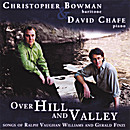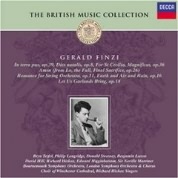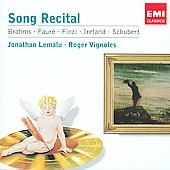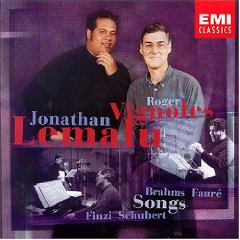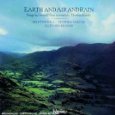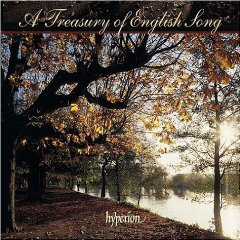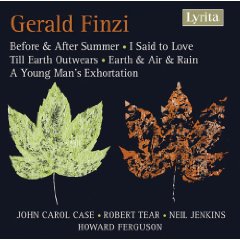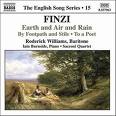Proud Songsters
Poet: Thomas Hardy
Date of poem: undated
Publication date: 1928
Publisher:
Collection: Winter Words
History of Poem:
Poem
Proud Songsters |
||
|---|---|---|
| 1 | The thrushes sing as the sun is going, | |
| 2 | And the finches whistle in ones and pairs, | |
| 3 | And as it gets dark loud nightingales | |
| 4 | In Bushes | |
| 5 | Pipe, as they can when April wears, | |
| 6 | As if all Time were theirs. | |
| 7 | These are brand-new birds of twelve-months' growing, | |
| 8 | Which a year ago, or less than twain, | |
| 9 | No finches were, nor nightingales, | |
| 10 | No thrushes, | |
| 11 | But only particles of grain, | |
| 12 | And earth, and air, and rain. | |
(Hardy, 835-6) |
||
Content/Meaning of the Poem:
Speaker:
Setting:
Purpose:
Idea or theme:
Style:
Form:
Synthesis:
Published comments about the poem:
✦✼✦✼✦✼✦✼✦✼✦✼✦✼✦✼✦✼✦✼✦✼✦✼✦✼✦✼✦✼✦✼✦✼✦
✦✼✦✼✦✼✦✼✦✼✦✼✦✼✦✼✦✼✦✼✦✼✦✼✦✼✦✼✦✼✦✼✦✼✦
Musical Analysis
Composition date:
Publication date:
Publisher: Boosey & Hawkes - Distributed by Hal Leonard Corporation
Tonality:
Transposition:
Duration:
Meter:
Tempo:
Form:
Rhythm:
Melody:
Texture:
Vocal Range:
Tessitura:
Dynamic Range:
Accompaniment:
Published comments about the music:
Pedagogical Considerations for Voice Students and Instructors:
✦✼✦✼✦✼✦✼✦✼✦✼✦✼✦✼✦✼✦✼✦✼✦✼✦✼✦✼✦✼✦✼✦✼✦
✦✼✦✼✦✼✦✼✦✼✦✼✦✼✦✼✦✼✦✼✦✼✦✼✦✼✦✼✦✼✦✼✦✼✦
| Pitch Analysis | ||||||
|---|---|---|---|---|---|---|
| pitch | stanza 1 |
stanza 2 |
stanza 3 |
stanza 4 |
total | |
highest |
A |
|||||
G |
||||||
F |
||||||
E |
||||||
D |
||||||
middle C |
||||||
B |
||||||
A |
||||||
G |
||||||
F |
||||||
lowest |
E |
|||||
| Rhythm Duration Analysis of Vocal Line | |||||
|---|---|---|---|---|---|
| stanza 1 | stanza 2 | stanza 3 | stanza 4 | total | |
16th note |
|||||
8th note |
|||||
dotted 8th |
|||||
quarter note |
|||||
dotted quarter |
|||||
triplet |
|||||
half note |
|||||
dotted half |
|||||
stanza total |
|||||
✦✼✦✼✦✼✦✼✦✼✦✼✦✼✦✼✦✼✦✼✦✼✦✼✦✼✦✼✦✼✦✼✦✼✦
Audio Recordings
Over Hill and Valley: Songs of Ralph Vaughan Williams and Gerald Finzi |
|
|
|
The British Music Collection: Gerald Finzi |
|
|
|
Song Recital |
|
|
|
Songs: Brahms - Faure - Finzi - Schubert |
|
|
|
The Songs of Gerald Finzi to Words by Thomas Hardy
|
|
|
|
A Treasury of English Song |
|
|
|
Gerald Finzi |
|
|
|
The English Song Series - 15 |
|
|
|
✦✼✦✼✦✼✦✼✦✼✦✼✦✼✦✼✦✼✦✼✦✼✦✼✦✼✦✼✦✼✦✼✦✼✦
The following is an analysis of Proud Songsters by Gerhardus Daniël Van der Watt. Dr. Van der Watt extended permission to post this excerpt from his dissertation on October 8th, 2010. His dissertation dated November 1996, is entitled:
The Songs of Gerald Finzi (1901-1956) To Poems by Thomas Hardy
This excerpt comes from Volume II and begins on page 249 and concludes on page 257. To view the methodology used within Dr. Van der Watt's dissertation please refer to: Methodology - Van der Watt.
1. Poet
Specific background concerning poem:
The poem comes from Hardy's last volume of poetry, Winter Words (2 October 1928), published some months after his death. In the Introductory Note to the volume, Hardy writes:
This being probably my last appearance on the literary stage, I would say, more seriously, that though, alas, it would be idle to pretend that the publication of these poems can have much interest for me, the track having been adventured so many times before to-day, the pieces themselves have been prepared with reasonable care, if not quite with the zest of a young man new to print. (1928:i)
The poem itself is undated but was probably written after the publication of Human Shows in 1926, and is a pastoral lyric of uncommon beauty. It reminds of "The Darkling Thrush" (Poems of the Present and the Past) which is "a song of hope from the depths of an extreme and extraordinarily scepticism." (Seymour-Smith, 625)
2. Poem
Proud Songsters |
||
|---|---|---|
| 1 | The thrushes sing as the sun is going, | a |
| 2 | And the finches whistle in ones and pairs, | b |
| 3 | And as it gets dark loud nightingales | c |
| 4 | In Bushes | d |
| 5 | Pipe, as they can when April wears, | b |
| 6 | As if all Time were theirs. | b |
| 7 | These are brand-new birds of twelve-months' growing, | a |
| 8 | Which a year ago, or less than twain, | e |
| 9 | No finches were, nor nightingales, | c |
| 10 | No thrushes, | d |
| 11 | But only particles of grain, | e |
| 12 | And earth, and air, and rain. | e |
(Hardy, 835-6) |
||
The poem, as do many of Hardy's poems, utilizes the 'end-of-day' mood of contemplation and reflection on natural phenomena. Here the unconscious gaiety of a number of young birds is reflected upon: the birds (symbolizing nature) act as though they own Time and are unaware of their fleeting existence. They are less than two years old and they behaves though they have always been around and always will be, for that matter. The persona, staying an impersonal observer, wonders at nature's audacity at not being aware of the slightness of its existence. A number of lexical sets are used to contrast one another and create subtle ambivalence in the poem:
"sun is going, gets dark, April wears, if...Time were"
- A set suggesting uncertainty, melancholy, weariness"thrushes sing, finches whistle, nightingales pipe"
- A set supporting delight, pleasure, tranquillity"brand-new, twelve-months' growing, year ago, less that twain"
- A set suggesting youthfulness, freshness"grain, earth, air, rain"
- A set embracing the essence of nature
It is clear that with remarkably simple language used in a specific way, a particularly subtle mood and atmosphere can be achieved.
The poem is a pastoral lyric with an invisible, observing, but commenting persona. The poem consists of two sextets, with a intricate rhyme scheme: abcdbb aecdee - a similar structure for the two stanzas and rhyming cross-reference. The fourth line in each stanza is shortened for visual interest as well as emphasizing the last two lines.
A simple-seeming pastoral lyric, it has an undercurrent reference to age and the passing of time, and nature's utter ignorance of it as a factor in existence. The poet is filled with wonder, both at the music made by the birds and at their creation. Less than two years before, these vibrant creatures were nothing but "particles of grain and earth and air and rain". The birds in the poem (representing Nature), seeming unaware of youth or age, accept existence for what it is and take what comes their way. Nature disregards, to its advantage, the passing of time and does not question but simply enjoys and does what it does best: Sing, whistle, pipe!
Setting
1. Timbre
VOICE TYPE/RANGE
The song is set for baritone and the range is a minor tenth from the second B below middle C. The warmth of the register and voice type is particularly suitable to the song.
The piano seems to be more important than the vocal part in the song if one considers that in 26 bars (or in 65% of the bars) the piano is not accompanied by the voice.
The accompaniment ranges from the C sharp two octaves above middle C in the treble clef to the B three octaves below middle C in the bass clef, thus roughly five octaves. These very low octave doublings are isolated occurrences (b. 12-13, 19, 37-38) and do not dominate the overall middle range sonority. The right hand material is notated in the bass clef in only about two bars (b. 112-131). There are no indications of pedal use other than what the word legato suggests. Pedal use will nevertheless be vitally important for a successful performance.
Legato playing is the main articulation feature with not a single staccato required. Legato playing is specified repeatedly (b. 1, 15 (sempre legato), 30). Apart from these, there are many legato slurs of varying lengths. The shorter ones with a more specific meaning and effect are listed: Bars 22-231 where played suspensions are slurred; bars 233-243 where semi-quaver bird-call motifs are slurred; bars 354-371 where weak/strong chords are slurred. The only other articulation indication of note is the portamento accent (b. 2(4), 54-62, 72-4, 10(8), 11(3), 20, 25(4), 294). These indications serve as mild accents to highlight a specific melodic moment. The "gradual accent in bar 15 on two accented non-chordal tones will be difficult to realize since there is a sing crotchet preceding it. Finally, a ten. is used on the last chord (b. 40).
The mood created in the song is fairly uniform with subtle shifts between major and minor. The long piano prelude (b. 1-15 is in b minor and sets a wistful, melancholy mood. harmonic second (major and minor) intervals suggest the "imperfect tuning" of natural bird calls (b. 1-3). The first stanza (b. 16-23) oscillates between b natural minor (with no raised seventh) and D major. The ambivalence is largely due to the non-chordal tones which obscure the harmony that the bass notes suggest. There is, however, a slightly more positive mood here, still pensive but not cheerless. Towards the end of the stanza and into the piano interlude (b. 23-29) a crescendo over tow and a half bars leads to the climax, reached by the piano alone, lasting for a bar and then resigning into a real D major in bar 272. This pleasant and tranquil mood with few sombre references, lasts through stanza 2 (b. 27-37) and the first one and a half bars of postlude (b. 37-382). The last bit of postlude (b. 384-40) returns to the opening material and mood, briefly, but intentionally.
2. Duration
METRE
The textual metre is iambic with slight deviations and is matched with a common-time time-signature throughout. There are two short, internal metric deviations: the first in bars 5-81 where a new three- crotchet note motif suggests a "four bar" simple triple time-signature. The call-and-response-structure between treble and bass suggests that two nightingales are calling to one another "as it gets dark" (l. 3). The same motif is rhythmically contracted and varied in bars 13-14. the triple metre structure, now is semi-quavers, is less strictly applied.
Rhythmic motifs
With the piano playing a leading role in the song, it is not surprising that rhythmic motifs are in abundance. Motif 1 consisting of a semi-quaver, quaver and semi-quaver, a motif with a jerky character, has a certain rustic or pastoral effect especially with it 88 occurrences, only two of which are in the vocal part (b. 17,18). Motif 2 consisting of a dotted quaver, semi-quaver and crotchet, occurs 22 times between bars 1 and 28 and twice in bars 38-40. The first note of this motif is usually the non-chordal tone that creates the dissonant bird call. Four single crotchets occurring in the bass appear 15 times of which in three bars (b. 9, 10 and 20) as a staccato crotchet, they have the harmonic and metric function of retaining stability. A shortening of motif 1 (semi-quaver and dotted quaver) has a vocal origin in the setting of words like "thrushes, finches, bushes" etc. and is used 12 times in the setting of both piano and vocal parts. In stanza 2 two motifs establish themselves, motif 3 consisting of two quavers and a crotchet which occurs seven times between bars 30 and 38 and the stronger motif 4 consisting of a dotted crotchet and a quaver which occurs 19 times in the same section. The latter is used in conjunction with melodic suspension and these two musical elements are powerful tools in creating the kind of ambivalence that is present here: the incessant rhythmic and melodic suspension over an harmonic pleasantness, sensitively captures the idea that nature's creatures are oblivious of the fragility of their own existence. Finally, the rhythmic augmentation of motif 1, as it appears in bar 284 in the bar following immediately (b. 29), helps to slow down the rhythmic activity in anticipation of the section that follows (b. 30-38).
Rhythmic activity vs. Rhythmic stagnation
There are 24 rhythmically active bars 9b. 1-4, 8-28) and 10 less active bars (b. 29-38). These coincide with the subtle mood and meaning changes suggested in the poem. The most stagnant bars are 5-7 of which the rhythmic and melodic features have already been discussed.
Rhythmically perceptive, erroneous and interesting settings
The following words have been perceptively or interestingly dealt with rhythmically:
Lengthening of voiced consonants
The following words containing voiced consonants have been rhythmically prolonged in order to make the word more singable:
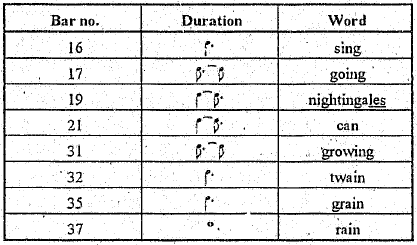
The tempo indication is Andante ![]() There are three deviations from this tempo which are listed below:
There are three deviations from this tempo which are listed below:

3. Pitch
Intervals: Distance distribution
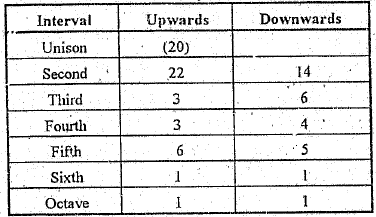
There are 20 repeated pitches (or 23% of the total number), 36 rising intervals (or 41%) and 31 falling intervals (or 36%). The smaller intervals (a third and smaller) account for 65 intervals (75% of the total number) while the larger intervals (fourths and larger) account for 22 (or 25%). In a vocally sympathetic context, like this, larger leaps require careful scrutiny which is recorded in the following table.
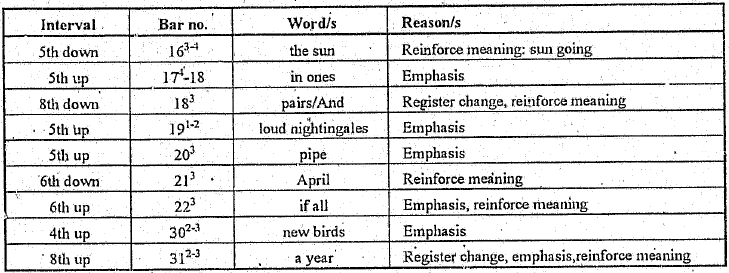
It is clear that the larger intervals have been employed to suit specific words and phrases in the text either to emphasize them or to reinforce the immediate meaning of the word within the context.
Melodic curve
A melodic curve of the vocal line is represented below. Aspects of the text meaning is indicated to show the relationship between the melodic curve and the meaning:

Climaxes
The two vocal climaxes are given below:

Although the climactic instances in the vocal line are significant within their specific contexts, the real climax of the song occurs in the piano part in bar 25 after a fairly long crescendo to the highest dynamic level, if not the highest pitch (which occurs in bar 24 (C sharp)).
Phrase lengths
Three of the four vocal phrases (excluding b. 344-37) will require an interruption for the sake of breathing, due to the fact that they are too long to be sung with ease: bars 154-202 (breathe at 183), bars 203-23 (breathe at 221) and bars 30-342 (breathe at 312). These are all at tied notes and should not interrupt the musical tension.
The basic keys are a mixture of b minor and D major. The song begins and ends in b minor. All modulations are summarized below.

Chromaticism
Chromaticism is associated with bird calls in bars 5-7 and 13-151. In the latter case a six-note chromatic passage occurs twice, the first time over a tonic pedal note. These bars also support the "going" of the sun (l. 1). The G# in bar eight can be seen as a raised step six in b melodic minor.
HARMONY AND COUNTERPOINT
the chord iv11, occurs five times in the prelude and interlude (b. 12, 32, 114, 252, 272) and has a striking effect related to the "imperfectly tuned" bird calls mentioned earlier. Another interesting chord occurs in bar 333, IV9 with the word "nightingales". Both these are harmonic accents.
Non-harmonic tones
Accented non-chordal tones have a significant place in the song due to their almost incessant occurrence. A portion of the analysis of these non-chordal tones is given to serve as an example:
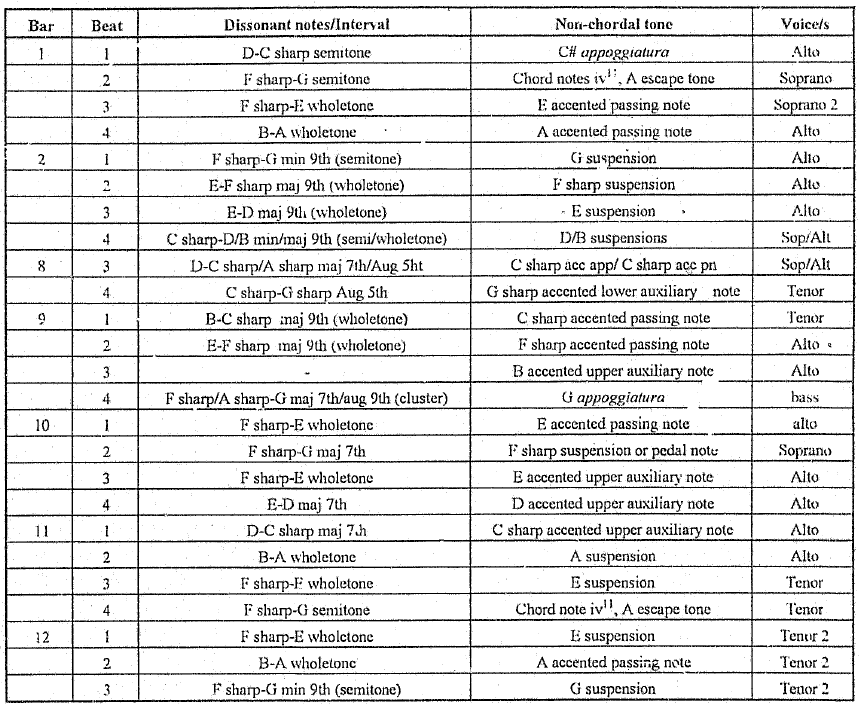
It is clear that the non-chordal note causing the dissonance is of a different type in each case. The point is, however, they all have the same effect which is what this analysis, hardly short of being tedious, shows. These non-chordal tones and the other parallel to them, not shown, are the real governors of the mood of the song. They start off as being reminiscent of "imperfectly tuned" bird call but become a harmonic or more precisely, non-harmonic motif with multiple musical purposes:
- Structurally binding
- Tonally evading
- Texturally enriching
- Mood determining
Lastly, the motifs in the treble of bars 233, 241 and 243 deserve mentioning. These three, sequentially moving upward with the crescendo, show the non-chordal tone explicitly as bird calls, particularly due to the piano register. Bar 233 - C sharp (suspension), A (escape tone): bar 241 - E (upper auxiliary), F sharp (chord note); bar 243 - C sharp (appoggiatura), E (upper auxiliary).
Harmonic devices
There are two inverted pedal notes in the vocal part (b. 23, 37), each at the end of a stanza, simply prolonging the final note for the sake of strengthening the cadence. There are two instances of pedal point or inverted pedal point in the piano part: bars 13-14 (B-tonic) and 20-21 (F sharp-dominant). In both cases they serve as tonal anchors with some dissonance created against them.
Counterpoint
There are no examples of counterpoint between piano and voice. The piano, internally, uses imitative procedures twice. The call-and-response structure of bars 5-7 has already been mentioned. There is further imitation between the tenor and soprano parts of bars 10-11. This imitation does not seem to be directly related to the meaning of the text, but does reinforce the opening melodic material.
Loudness variation is given in the following summary:
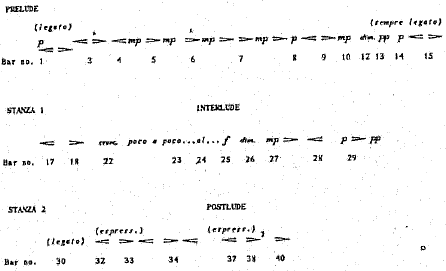
FREQUENCY
There are 42 indications in the 40 bars which means that on average each bar contains an indication. In reality some bars do not contain indications while others contain two or three. There are no separate indications for the voice which implies that the voice should follow the indications given in the piano part.
RANGE
The highest dynamic level, f (b. 25) occurs only once, namely at the piano climax of the song. The lowest level, pp occurs twice. In bar 13 a chromatic passage against a pedal point tonic is marked pp. The implication of the other indication in bar 29 is more ambiguous. It seems to imply that the rest of the song (b. 29-40) should be a the pp level with only minor crescendo and decrescendo indications.
VARIETY
The indications used are:
![]()
DYNAMIC ACCENTS
There are no stronger accents than the portamento accents. These have been listed and discussed under piano articulation above.
The density varies loosely between two and seven parts including both piano and voice. The thickness of the piano part is represented in the following table:
More than half of the song has a four-part texture and between three- and four-parts, 75% of the bars are accounted for. The densest texture occurs in bars 35-6 where six-part chords alternate between chords ii43, I64 and IV (in D major). The textural fullness of these chords is connected with the meaning and structure of the adjacent text, "grain, / and earth, and air and rain" (the abundance of Nature and the listing of features). This textures are limited to bars 5, 14 and 29. In the first two, the textures are bird-call related and third anticipates the start of stanza 2.
The structure of the song is represented in the following table:

The song is in a sort of rondo form while not explicitly so. The two stanzas are set using the through-composed technique and the piano provides the rondo theme.
7. Mood and atmosphere
The piano accompaniment largely carries the mood of the song: it is pastoral but somewhat melancholic with bird calls which are discordant. The atmosphere is never despairing but rather mellow, world weary, nostalgic and pleasant at times. The reference to the opening material in bars 38-40 possibly swings the balance in favour of melancholy with the realization of the poet, supported by the setting of the composer, that nature cannot really console him (them) with its innocence and beauty because it does not understand the nature of its existence.
General comment on style
The vocal style is sympathetic and idiomatic while the piano accompaniment is really the significant partner in the song. The gentle tonal play between b minor and D major, the extensive use of rhythmic and melodic motifs, the ingenious use of non-chordal tones and the subtle shifts of mood, capture the sensitive ambience of the poem. The pianistic playing style is comfortable and the material is suitable, always avoiding excess.
Unpublished Analysis Excerpts
The following is an analysis of Proud Songsters by Curtis Alan Scheib. Dr. Scheib extended permission to post this excerpt from his dissertation on February 17th, 2012. His dissertation dated 1999, is entitled:
Gerald Finzi's Songs For Baritone On Texts By Thomas Hardy: An Historical And Literary Analysis And Its Effect On Their Interpretation
This excerpt begins on page fifty and concludes on page fifty-two.
Proud Songsters |
||
|---|---|---|
| 1 | The thrushes sing as the sun is going, | |
| 2 | And the finches whistle in ones and pairs, | |
| 3 | And as it gets dark loud nightingales | |
| 4 | In Bushes | |
| 5 | Pipe, as they can when April wears, | |
| 6 | As if all Time were theirs. | |
| 7 | These are brand-new birds of twelve-months' growing, | |
| 8 | Which a year ago, or less than twain, | |
| 9 | No finches were, nor nightingales, | |
| 10 | No thrushes, | |
| 11 | But only particles of grain, | |
| 12 | And earth, and air, and rain. | |
(Hardy, 835-6) |
||
In the last of the poems Finzi includes in the set, Hardy expresses the cyclical nature of life and the earth's perennial sorrow. The song begins with an extended introduction in B minor that seems to encapsulate all of the contrasting emotion of the previous nine songs. Finzi uses a longing appoggiatura figure, seen in example 16, over a syncopated pulse.
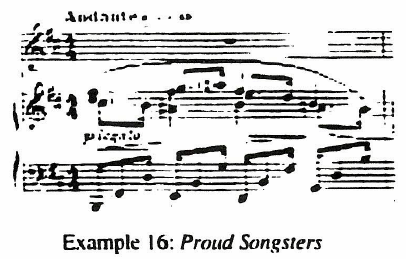
The emotional storm begins to die away however as the voice and new life make their entrance, the vocal line shaped by the declamation of the text (example 17).

The syncopated figure continues to underlie the voice and rises again at the end of the first verse, time seeming to move with increasing speed and turbulence. Time is suspended for a moment and the second verse begins in a beautifully lyric D Major section, the music expressing the almost inexpressible longing of the earth. In a final gesture, it seems uncertain whether the song will end in D Major or B minor. After a suspension of time over a quarter rest, the song returns to the B minor of the beginning, the longing unanswered.
The preceding was an analysis of Proud Songsters by Curtis Alan Scheib. Dr. Scheib extended permission to post this excerpt from his dissertation on February 17th, 2012. His dissertation dated 1999, is entitled:
Gerald Finzi's Songs For Baritone On Texts By Thomas Hardy: An Historical And Literary Analysis And Its Effect On Their Interpretation
The excerpt began on page fifty and concluded on page fifty-two.

